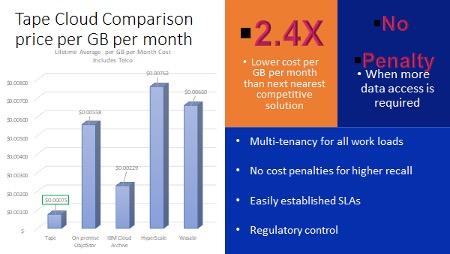This is a question that is often asked, possibly from the surprise that a technology that is seemingly as old as computing itself is still in use, a question driven by the concerted campaign of disk vendors saying that “tape is dead”.
In fact, tape is used by all of the largest and most successful IT companies around the world and more and more tape capacity is shipped and used every year.
Tape –
- Is used by 67 percent of current users for archiving, and 57 percent of current users for backup
- Has far greater potential to meet predicted capacity growth over the next decade than HDD technologies
- Is 86 percent less expensive than disk storage in a 10-year TCO comparative study
- Is twice as reliable than disk
A better question would be – Why not use Tape?
If a data centre, corporate or SME was creating its ideal storage solution they would have the following “wish list”
- Fast
- Reliable
- Ransomware protection
- Very low TCO
- Data immutability
- AES 256-bit encryption of data at rest
Tape meets all of these requirements and more. Whilst the disk vendors are reaching capacity limits, tape has plenty of room to grow. Lab demonstrations by IBM indicate a potential for over 30x the density and capacity that today’s drives are reaching.
We now talk about Tape 3.0. – having been used first for backup, then for archive and now for almost any storage need.
Modern tape is now finding its way onto film sets as film companies and their insurers realise the importance of tape as the only suitable medium for saving camera cards to. The “hyper scalers” providing Cloud Services all use IBM designed Tape Solutions and so do large research projects and weather forecasters. CERN will even sell you an old Storage Tek tape full of LHC data in the souvenir shop while they capture their new experiments on IBM tape drives and tape.
In the Cloud or “on Prem”?
One of the huge storage success stories in recent years has been the Cloud Service Provider (CSPs), who, for a monthly fee rent out their tape libraries and access to them. This may be a good solution for a small business that is not generating a large amount of data as it allows them to exchange upfront costs for a monthly cost and may provide them with a better (modern Tape) storage vs their current setup.
One of the real strengths of tape is its incredibly low cost for archiving “cold” data. 80% of a company’s data is unlikely to be accessed and if this is costing money to store each month the temptation may be to simply delete it to free up space and budget This could be a huge mistake, as the true value of that data to the company may not become apparent for many years. Some examples over the years include seismic data – as oil prices increase and techniques improve the data may suddenly become relevant again. Media & Entertainment Companies have benefited from huge additional revenues from the back catalogue, where it was still available. Songs not included in Guitar Hero game were simply deleted by the record company to save disk space and are now impractical to record again, depriving many of a previously unimagined source of revenue. The next change will be AI where companies who still have affordable access to old data can run analytics and gain valuable insight their competitors simply cannot.
Whilst CSPs provide a good service in many respects this approach does not suit all companies. Security and Compliance standards are those of the CSP, not the organisation that owns the data.
The bandwidth of the internet connection may not matter when sending incremental data up to the cloud, but in the event of a failure or ransomware attack, this may well become a restriction on restore time, requiring disks being written to at the CSP and posted or couriered to the customer.
The cost of using Cloud Services can rapidly add up – there are well published examples of 10 fold savings by going back “on prem” – “Not doing the sums on repatriation is ‘financial malpractice at this point’”
Please contact us for a cost calculator to help your customer better understand the cost implications of Cloud Computing.
The future is probably going to be “hybrid” cloud – something IBM can certainly help with as they have been using and developing this sort of system since the mid 80s.
